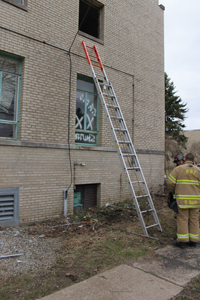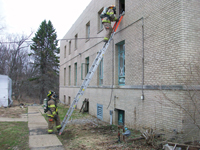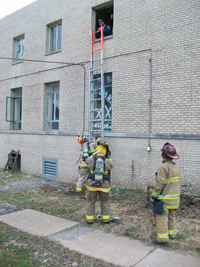
Features
Training
Back to Basics: June 2010
Ground ladders are a big part of truck company operations. As mentioned in Back to Basics in September 2009, firefighters need to train and practise the raising and placing of ground ladders with just one person. Due to manpower issues, we cannot always dedicate two people to raising a 24-foot ground ladder. Ideally, a single firefighter can effectively ladder a residential structure.
June 4, 2010
By Mark van der Feyst
Ground ladders are a big part of truck company operations. As mentioned in Back to Basics in September 2009, firefighters need to train and practise the raising and placing of ground ladders with just one person. Due to manpower issues, we cannot always dedicate two people to raising a 24-foot ground ladder. Ideally, a single firefighter can effectively ladder a residential structure.
 |
|
| Photo 1: This ladder is at an angle of less than 75 degrees but it allows a firefighter to climb up, gain entry and bring the victim down the ladder safely. Photo by Mark van der Feyst |
Part of the raise operation includes angling the ladder to the correct climbing angle.
The ideal climbing angle for any ladder is 75 degrees, or one-quarter of the ladder’s working height. While we teach new firefighters the right way to set the climbing angle, it’s not always possible in emergency situations to follow all the steps we teach.
At structural fires, we should ladder all sides of the building, or at least two sides. This provides interior crews with at least two exit points and a quick ingress point for the rapid intervention team. We also ladder structures for victim rescue. When fire victims are hanging out a window, ready to jump or yelling at us for help, we need to quickly raise and position the ladder to rescue them. Checking the correct climbing angle is not a part of this operation.
Each ground ladder has labels containing safety messages, warnings and heat cautions. Some labels show the correct method for setting the climbing angle once the ladder has been raised. These labels are often found on the side beams of the ground ladder and show a stick figure measuring the ladder to ensure the 75-degree angle. The label even includes a four-step process:
- Place toes at bottom of ladder’s side rails;
- Stand erect;
- Extend arms straight out;
- Make sure palms of hands touch top of rungs at shoulder level.
We instruct our crews to use this four-step process when trying to determine the correct climbing angle. Taking the time to follow the four-step process while a victim is hanging out the window ready to jump is not a wise decision. When trying to ladder a building in a non-emergency situation, taking the time to ensure a good climbing angle is wise.

|
|
| Photo 2: The ladder is set at less than 75 degrees, but this still works for the operation. Photo by Mark van der Feyst |
Another type of label sometimes found on the side of ground ladders features an L diagram that shows when you have the proper climbing angle. When you put the ladder against the support wall vertically, the L is crooked and points toward the ground. When you pull the ladder out from the support wall, the L straightens out and appears just as you would write it on a piece of paper. When the bottom part of the L is parallel with the ground, the climbing angle is correct. This type of label is a quick reference guide and can be useful when trying to place a ground ladder but it’s difficult to see at night as it’s printed in black.
Ground ladders are very strong and, as noted in September’s column, are tested to ensure maximum working conditions. If a ground ladder is placed against a building at an angle of less than 75 degrees, will this hinder our climbing operations? No, it will not. But if the ladder is set at an angle of more than 75 degrees, we are in trouble. A ladder set at 80 degrees is very intrusive when trying to climb for entry, or when rescuing a person from the building. And a ladder set at an angle of 50 degrees or less will be dangerous; the butt spurs will kick out when someone steps onto it, especially on a concrete surface.
Photo 1 shows a ground ladder at a training exercise during which teams were practising vent, enter and search techniques. The ground ladder was raised and set without checking for a proper climbing angle. The idea was to move quickly because the crew needs to search and remove a victim from the room on the third floor. Note that the ladder tip is not exactly at the bottom of the window sill – it is about six inches too short – and the base of the ladder is not at the edge of the concrete walkway. Is this ladder at a 75-degree angle? Probably not. But it is at an angle that allows a firefighter to climb up, gain entry and bring the victim down the ladder without hindering any efforts. It is at an angle of less then 75 degrees.
In photo 2 the ladder tip is immediately below the window sill and the base is at the edge of the concrete walkway. There are five rungs extended beyond the bed section of the ladder, compared with just four rungs extended in photo 1. Again, this angle will work for the operation, although the ladder is set at less than 75 degrees.
 |
|
| Photo 3: The tip is extended beyond the window sill by one rung and then the base is pulled away from the building, giving you a good climbing angle. Photo by Eric Wissner |
Another good reason to have a ground ladder set at less than 75 degrees is firefighter survival. If interior crews need to bail out of the building, then having a ground ladder set at less than 75 degrees offers a less intrusive angle for a head first ladder bail.
To determine a good climbing angle when the ground ladder is vertically against the wall of the building, raise the fly section so that the tip of the ladder extends beyond the window sill by one rung, as shown in photo 3. At this point, the base of the ladder can be pulled out from the building; stop when the tip of the ladder drops below the window sill. In this situation, the ladder tip drops one foot for every four feet we pull the base out from the wall – one-quarter of the ladder’s working height.
This will work well only when we train and practise on different windows in our response districts. Do not dwell on setting the climbing angle to exactly 75 degrees; make sure that it is set at a good angle that allows you to climb and conduct your assigned operation.
Mark van der Feyst is an 11-year veteran of the fire service. He works for the City of Woodstock Fire Department in Ontario and is an instructor teaching in Canada and the U.S. He is a local level suppression instructor for the Pennsylvania State Fire Academy, an instructor for the Justice Institute of BC and a professor of fire science for Lambton College in Ontario. He can be reached at Mark@FireStarTraining.com.
Print this page